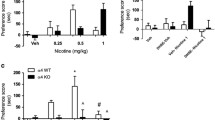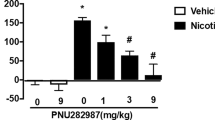Abstract
Rationale
The extent to which non-α4β2 versus α4β2* nAChRs contribute to the behavioral effects of varenicline and other nAChR agonists is unclear.
Objectives
The purpose of this study was to characterize the discriminative stimulus effects of varenicline and nicotine using various nAChR agonists and antagonists to elucidate possible non-α4β2 nAChR mechanisms.
Methods
Separate groups of male C57BL/6J mice were trained to discriminate varenicline (3.2 mg/kg) or nicotine (1 mg/kg). Test drugs included mecamylamine; the nAChR agonists epibatidine, nicotine, cytisine, varenicline, and RTI-102; the β2-containing nAChR antagonist dihydro-β-erythroidine (DHβE); the α7 nAChR agonist PNU-282987; the α7 antagonist methyllycaconitine (MLA); the α3β4 antagonist 18-methoxycoronaridine (18-MC); and the non-nAChR drugs midazolam and cocaine.
Results
In nicotine-trained mice, maximum nicotine-appropriate responding was 95% nicotine, 94% epibatidine, 63% varenicline, 58% cytisine, and less than 50% for RTI-102, PNU-282987, midazolam, and cocaine. In varenicline-trained mice, maximum varenicline-appropriate responding was 90% varenicline, 86% epibatidine, 74% cytisine, 80% RTI-102, 50% cocaine, and 50% or less for nicotine, PNU-282987, and midazolam. Drugs were studied to doses that abolished operant responding. Mecamylamine antagonized the discriminative stimulus effects, but not the rate-decreasing effects, of nicotine and varenicline. DHβE antagonized the discriminative stimulus and rate-decreasing effects of nicotine but not varenicline in either the nicotine or varenicline discrimination assays. The discriminative stimulus, but not the rate-decreasing, effects of epibatidine were antagonized by DHβE regardless of the training drug.
Conclusions
These results suggest that α4β2* nAChRs differentially mediate the discriminative stimulus effects of nicotine and varenicline, and suggest that varenicline has substantial non-α4β2 nAChR activity.




Similar content being viewed by others
References
Abdrakhmanova GR, Damaj MI, Carroll FI, Martin BR (2006) 2-Fluoro-3-(4-nitro-phenyl)deschloroepibatidine is a novel potent competitive antagonist of human neuronal α4β2 nAChRs. Mol Pharmacol 69:1945–1952
Brioni JD, Kim DJ, O’Neill AB (1996) Nicotine cue: lack of effect of the α7 niconic receptor antagonist methyllycaconitine. Eur J Pharmacol 301:1–5
Chandler CJ, Stolerman IP (1997) Discriminative stimulus properties of the nicotinic agonist cytisine. Psychopharmacology 129:257–264
Colpaert FC (1988) Intrinsic activity and discriminative effects of drugs. In: Colpaert FC, Balster RL (eds) Transduction mechanisms of drug stimuli. Springer Berlin Heidelberg, Berlin, pp 154–160
Colpaert FC (1999) Drug discrimination in neurobiology. Pharmcol. Biochem Behav 64:337–345
Colpaert FC, Janssen PA (1984) Agonist and antagonist effects of prototype opiate drugs in rats discriminating fentanyl from saline: characteristics of partial generalization. J Pharmacol Exp Ther 230:193–199
Cunningham CS, McMahon LR (2011) The effects of nicotine, varenicline, and cytisine on schedule-controlled responding in mice: differences in α4β2 nicotinic receptor activation. Eur J Pharmacol 654:47–52
Cunningham CS, McMahon LR (2013) Multiple nicotine training doses in mice as a basis for differentiating the effects of smoking cessation aids. Psychopharmacology 228:321–333
de Moura FB, McMahon LR (2016) Differential antagonism and tolerance/cross-tolerance among nicotinic acetylcholine receptor agonists: scheduled-controlled responding and hypothermia in C57BL/6J mice. Behav Pharmacol 27:240–248
Desai RI, Bergman J (2010) Drug discrimination in methamphetamine-trained rats: effects of cholinergic nicotinic compounds. J Pharmacol Exp Ther 335:807–816
Garcha HS, Stolerman IP (1989) Discrimination of a drug mixture in rats: role of training dose, and specificity. Behav Pharmacol 1:25–31
Grady SR, Drenan RM, Breining SR, Yohannes D, Wageman CR, Fedorov NB, McKinney S, Whiteaker P, Bencherif M, Lester HA, Marks MJ (2010) Structural differences determine the relative selectivity of nicotinic compounds for native α4β2*-, α6β2*-, α3β4*- and α7-nicotinic acetylcholine receptors. Neuropharmacology 58:1054–1066
Grant K (1999) Strategies for understanding the pharmacological effects of ethanol with drug discrimination procedures. Pharmacol Biochem Behav 64:261–267
Green KL, Grant KA (1998) Evidence for overshadowing by components of the heterogeneous discriminative stimulus effects of ethanol. Drug Alcohol Depend 52:149–159
Hajós M, Hurst RS, Hoffman WE, Krause K, Wall TM, Higdon NR, Groppi VE (2005) The selective α7 nicotinic acetylcholine receptor agonist PNU-282978 [N-[(3R)-1-azabicyclo[2.2.2]octy-3-yl]-4-chlorobenzamine hydrochloride] enhances GABAergic synaptic activity in brain slices and restores auditory gating deficits in anesthetized rats. J Pharmacol Exp Ther 312:1213–1222
Hays JT, Ebbert JO, Sood A (2008) Efficacy and safety of varenicline for smoking cessation. Am J Med 121:S32–S42
Institute for Laboratory Animal Research (2011) Guide for the care and use of laboratory animals 8th ed. Institute for Laboratory Animal Research. Division of Earth and Life Sciences, National Research Council, Washington
Jutkiewicz EM, Brooks EA, Kynaston AD, Rice KC, Woods JH (2011) Patterns of nicotinic receptor antagonism: nicotine discrimination studies. J Pharmacol Exp Ther 339:194–202
Kenakin TP (1997) Pharmacologic analysis of drug-receptor interaction. Lippincott-Raven, Philadelphia
Kenakin T (2002) Drug efficacy at G protein-coupled receptors. Annu Rev Pharmacol Toxicol 42:349–379
Kuehne ME, He L, Jokiel PA, Pace CJ, Fleck MW, Maisonneuve IM, Glick SD, Bidlack JM (2003) Synthesis and biological evaluation of 18-methoxycoronaridine congeners. Potential antiaddiction agents. J Med Chem 46:2716–2730
Lummis SC, Thompson AJ, Bencherif M, Lester HA (2011) Varenicline is a potent agonist of the human 5-hydroxytryptamine3 receptor. J Phamacol Exp Ther 339:125–131
Mihalak KB, Carroll FI, Luetje CW (2006) Varenicline is a partial agonist at alpha4beta2 and a full agonist at alpha7 neuronal nicotinic receptors. Mol Pharmacol 70:801–805
Moerke MJ, de Moura FB, Koek W, McMahon LR (2016) Effects of nicotine in combination with drugs described as positive allosteric nicotinic acetylcholine receptor modulators in vitro: discriminative stimulus and hypothermic effects in mice. Eur J Pharmacol 786:169–178
Papke RL, Dwoskin LP, Crooks PA, Zheng G, Zhang Z, McIntosh JM, Stokes C (2008) Extending the analysis of nicotinic receptor antagonists with the study of alpha6 nicotinic receptor subunit chimeras. Neuropharmacology 54:1189–1200
Picciotto MR, Zoli M, Rimondini R, Léna C, Marubio LM, Pich EM, Fuxe K, Changeux JP (1998) Acetylcholine receptors containing the β2 subunit are involved in the reinforcing properties of nicotine. Nature 391:173–177
Rodriguez JS, Cunningham CS, Moura FB, Ondachi P, Carroll FI, McMahon LR (2014) Discriminative stimulus and hypothermic effects of some derivatives of the nAChR agonist epibatidine in mice. Psychopharmacology (Berl) 231:4455–4466
Rollema H, Chambers LK, Coe JW, Glowa J, Hurst RS, Lebel LA, Lu Y, Mansbach RS, Mather RJ, Rovetti CC, Sands SB, Schaeffer E, Schulz DW, Tingley FD III, Williams KE (2007a) Pharmacological profile of the α4β2 nicotinic acetylcholine receptor partial agonist varenicline, an effective smoking cessation aid. Neuropharmacology 52:985–994
Rollema H, Coe JW, Chambers LK, Hurst RS, Stahl SM, Williams KE (2007b) Rationale, pharmacology and clinical efficacy of partial agonists of α4β2 nACh receptors for smoking cessation. Trends Pharmacol Sci 28:316–325
Shoaib M, Gommans J, Morley A, Stolerman IP, Grailhe R, Changeux JP (2002) The role of nicotinic receptor beta-2 subunits in nicotine discrimination and conditioned taste aversion. Neuropharmacology 42:530–539
Smith JW, Mogg A, Tafi E, Peacey E, Pullar IA, Szekeres P, Tricklebank M (2007) Ligands selective for α4β2 but not α3β4 or α7 nicotinic receptors generalise to the nicotine discriminative stimulus in the rat. Psychopharmacology 190:157–170
Stolerman IP, Chandler CJ, Garcha HS, Newton JM (1997) Selective antagonism of behavioural effects of nicotine by dihydro-β-erythroidine in rats. Psychopharmacology 129:390–397
Stolerman IP, Naylor C, Elmer GI, Goldberg SR (1999) Discrimination and self-administration of nicotine by inbred strains of mice. Psychopharmacology 141:297–306
Stolerman IP, Chamberlain S, Bizarro L, Fernandes C, Schalkwyk L (2004) The role of nicotinic receptor α7 subunits in nicotine discrimination. Neuropharmacology 46:363–371
Tallarida RJ (2000) Drug synergism and dose-effect data analysis. Chapman Hall/CRC Press, Boca Raton
Ward JM, Cockcroft VB, Lunt GG, Smillie FS, Wonnacott S (1990) Methyllycaconitine: a selective probe for neuronal alpha-bungarotoxin binding sites. FEBS Lett 270:45–48
White JA, Stolerman IP (1994) Antagonism of a nicotine plus midazolam discriminative cue in rats. Behav Pharmacol 5:351–355
Acknowledgments
The authors thank Dr. F. Ivy Carroll for generously providing RTI-102 and Ursula Villarreal-Moura for editorial assistance.
Author information
Authors and Affiliations
Corresponding author
Ethics declarations
Funding
This work was supported by the National Institutes of Health National Institute on Drug Abuse [Grant DA25267].
Conflict of interest
The authors declare that they have no conflicts of interest.
Rights and permissions
About this article
Cite this article
de Moura, F.B., McMahon, L.R. The contribution of α4β2 and non-α4β2 nicotinic acetylcholine receptors to the discriminative stimulus effects of nicotine and varenicline in mice. Psychopharmacology 234, 781–792 (2017). https://doi.org/10.1007/s00213-016-4514-4
Received:
Accepted:
Published:
Issue Date:
DOI: https://doi.org/10.1007/s00213-016-4514-4




